El morro fort puerto rico: Exploring Castillo San Felipe del Morro in Old San Juan
A Guide to Visiting El Morro, the Historic Fort in San Juan, Puerto Rico (+ Photos and Tips!)
Exploring Castillo San Felipe del Morro, often known simply as El Morro, is one of the top things to do in Old San Juan.
The historic Puerto Rican citadel is part of the San Juan National Historic Site and also a UNESCO World Heritage Site.
Read on for the complete guide to visiting iconic El Morro!
El Morro looks majestic, viewed from the road
One of the oldest fortresses built in the Caribbean, El Morro is a fascinating place to visit in San Juan, especially if you enjoy history and military architecture.
And don’t forget your camera: you will love the beautiful views over the water!
The History of El Morro
El Morro, which means “the promontory,” was built to protect the city of San Juan from sea attacks, and is considered probably the foremost fortification built by the Spanish in the New World.
The iconic fort rises 140 feet from sea level, and its walls are as much as 18 to 25 feet thick in some places!
The beautiful textured walls of the fort
Named for King Philip II of Spain, El Morro stands as a historic landmark of the time of the exploration and colonization of the Americas.
Construction on El Morro started in 1539 at a site overlooking the entrance to San Juan Bay, and modifications continued until about 1790.
El Morro overlooks San Juan Bay
Over the centuries, other European powers tried to wrestle the coveted harbor of San Juan away from the Spanish.
In 1595, Sir Francis Drake, the famed English seaman and explorer, attacked San Juan. But the Spanish defenders of El Morro, aided by a mistake by Drake, managed to fend off the attack.
In 1598, the English attacked San Juan again, and this time they captured El Morro, but had to forsake it and withdraw after dysentery killed off many English troops.
In 1625, the Dutch attacked San Juan, but despite a siege, were unable to take over El Morro. They eventually gave up, but burnt the city before they left.
In 1797, the English tried again, and failed again.
It was only a century later, with the Spanish-American War of 1898, that El Morro’s defenses were powerless against newer and more technologically advanced artillery employed by the American naval troops.
With this war, Puerto Rico came under the rule of the United States of America, after centuries of Spanish rule.
El Morro came under US rule in 1898
The US military used El Morro as a base in both World Wars.
In 1961, El Morro became a part of the San Juan National Historic Site, and its proud status as an active defensive site came to an end.
In 1983, El Morro, along with the other fortifications in San Juan, was designated a UNESCO World Heritage Site.
Read the information exhibits to learn more about El Morro!
What to see at El Morro (Castillo San Felipe del Morro)
El Morro is set on a promontory overlooking the water, and in front of the main entrance is a vast expanse of undulating green lawn. From the road, take photos of the beautiful scene, before you make your way to the entrance.
Walking up to the main entrance of E l Morro
On nice weather weekends, you may see locals flying kites on the lawn.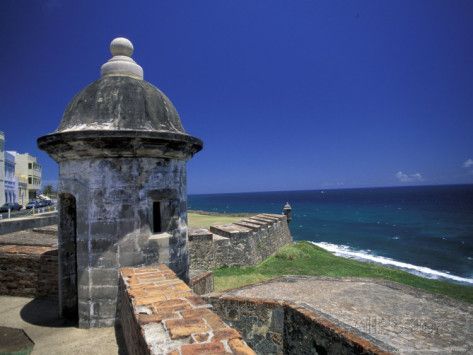 And from the pathway, or the lawn, you can see the Santa María Magdalena de Pazzis Cemetery on your right as you face the fort.
And from the pathway, or the lawn, you can see the Santa María Magdalena de Pazzis Cemetery on your right as you face the fort.
Passing through the entrance, you come to the main courtyard of El Morro, with its cheery yellow walls accented with white. On this level, you’ll find lots of boards with information on the fort and its history.
I love the bright yellow walls of the main courtyard at El Morro!
From the courtyard, or one of the terraces, you can take a photo of the three flags that fly at the fort: the flags of the USA and Puerto Rico, and the Cross of Burgundy flag, a historical flag flown by Spanish military sites during the 16th to the 18th centuries.
Flags fly at El Morro on a beautiful day in December
The fort is not very large in terms of area, but it is built over six levels, and ramps or flights of stairs connect the different levels. You can walk and explore almost all areas of the fort.
Admire the modest chapel, view the kitchen area, and walk through the living quarters.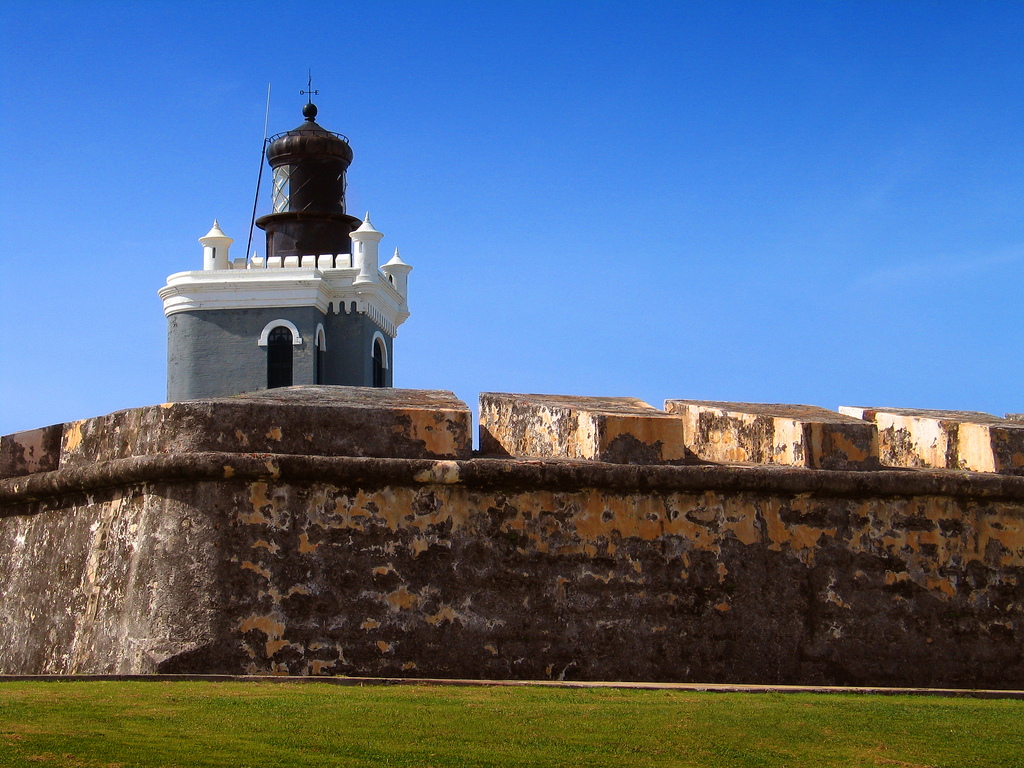 Peruse the old cannons, walk the old tunnels, and take in the views from the terraces.
Peruse the old cannons, walk the old tunnels, and take in the views from the terraces.
Peeking into the little chapel at the fortA cannon at El Morro, facing out to sea
Take photos of the picturesque sentry boxes (called garitas), and step inside one to look out over the water like the sentries of colonial times.
You’ll see the sentry boxes not just at El Morro but all along the fortifications of Old San Juan.
One of the picturesque sentry boxes at El Morro
On a bright sunny day, the views of the bay from the fort are spectacular. And the blue of the water contrasts beautifully with the tan walls of the rugged fort, making for gorgeous photos.
A beautiful view of San Juan Bay from El Morro!
Over to the right of the fort is the Old San Juan Cemetery, and further out, you can see the colorful houses of La Perla — the edgy coastal community just outside the old city, Castillo San Cristobal, and the highrises of San Juan.
The Old San Juan Cemetery and La Perla, seen from El Morro
The lighthouse at El Morro is the first lighthouse built in Puerto Rico. The original lighthouse was built in 1846, and a new tower was built in 1876.
The original lighthouse was built in 1846, and a new tower was built in 1876.
After it was hit during the Spanish-American War, a new lighthouse was built in 1899, but had to be torn down after structural issues developed.
The current stylish gray structure dates back to 1908.
The handsome gray lighthouse at El Morro
Learn more about the fort as you explore, by joining a ranger-led tour or by reading the many interpretive plaques and boards (in English and Spanish) located all over the fort.
The interpretive boards and plaques at the fort are very informative
And don’t forget to watch the film that tells you more about the park: it is shown at both El Morro and Castillo San Cristobal, and is super informative.
At El Morro, the theater is on the level where you enter.
Tips and information for visiting El Morro
El Morro is one of San Juan’s most popular attractions, and the sight is at the top of many visitors’ itineraries for San Juan.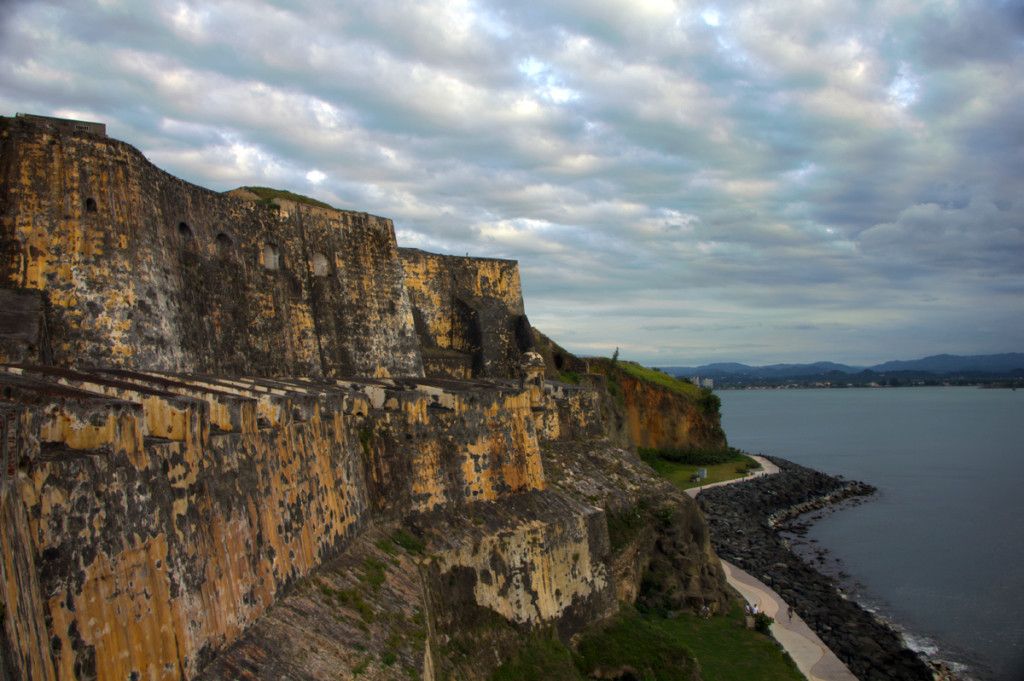 Here is my guide to visiting El Morro, with tips that will hopefully make your visit enjoyable and memorable!
Here is my guide to visiting El Morro, with tips that will hopefully make your visit enjoyable and memorable!
Where is El Morro located?
El Morro is located at 501 Calle Norzagaray in Old San Juan, the historic district of the Puerto Rican capital. It overlooks the San Juan Bay.
Getting to El Morro
If you are staying anywhere within Old San Juan, you can walk to El Morro. You can also ride on the Old San Juan Trolley, which is free and drops you right at the entrance to the fort.
From other districts in San Juan, you can drive yourself or take a taxi or an Uber to the fort.
If you arrive by car, there is an underground parking area at the end of the Norzagaray Street at the Fifth Centennial Plaza, from where you can walk to El Morro in about 5 to 10 minutes.
Admission to El Morro
There is an admission fee to visit El Morro. At the time of writing, the admission fee for an adult is USD10, and the fee covers both El Morro and the nearby Castillo San Cristobal.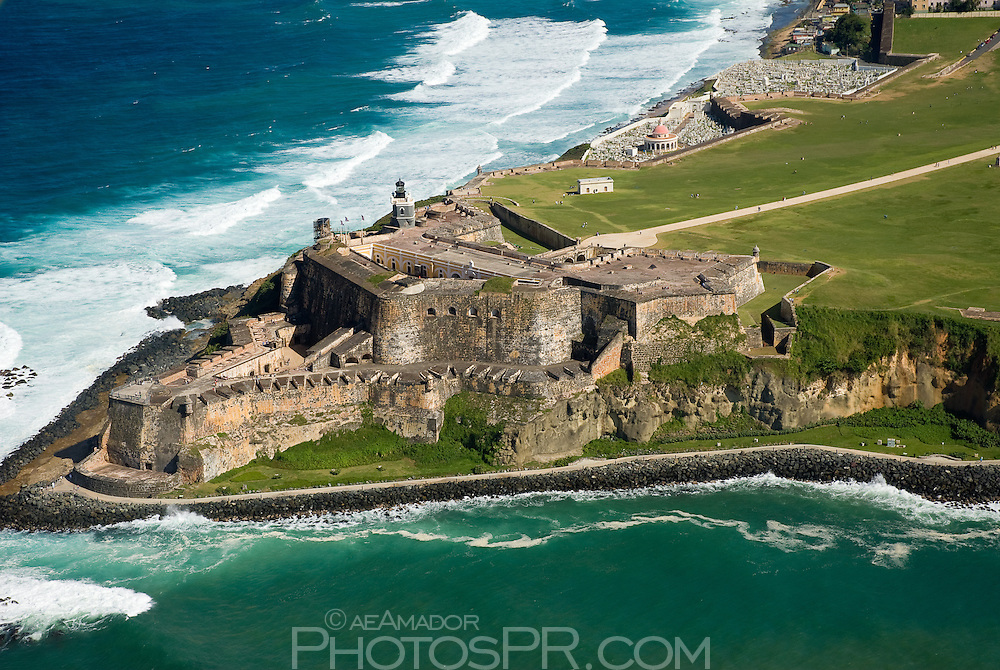
If you have an America the Beautiful National Parks pass, it covers admission to both El Morro and Castillo San Cristobal, so make sure you have your pass with you when you visit!
Don’t have a pass yet? Buy one online at REI! It’s valid for one year and pays for itself if you plan to visit several parks during the year.
Bring your National Parks pass: it is valid at El Morro!
You can buy tickets at the entrance to El Morro on the day of your visit. Pick up a brochure at the entrance desk.
How much time should you allow at El Morro?
Allow at least two hours to explore El Morro. We spent about 3 hours, but we explored every nook and cranny and took lots and lots of photos.
Check about ranger-led tours scheduled for the day you plan to visit, to maximize your experience at the fort.
If you have more time to spare after the tour, wander around on your own and take photos at leisure, or simply enjoy the views and the sense of history at El Morro.
Accessibility
El Morro is built over six levels, and involves stairs and ramps, sometimes steep. There are tunnels and narrow dark passages. Wear comfortable shoes and a light wrap for wind protection.
A ramp at El Morro connecting two of its six levelsSteps or ramps connect different levels of the fort
If you have mobility issues, you can still visit the main courtyard and other areas on that level, including the theater and the bookstore.
The best time to visit El Morro
As one of San Juan’s top attractions, El Morro tends to get crowded during the day, especially if you visit during the peak season (mid December through mid April).
Visit early in the day for a much more pleasant experience and the opportunity to explore and take photos in relative solitude.
Visit El Morro early in the day to avoid crowds
We were at the entrance at opening time, and there were just a handful of other visitors in the fort at the time.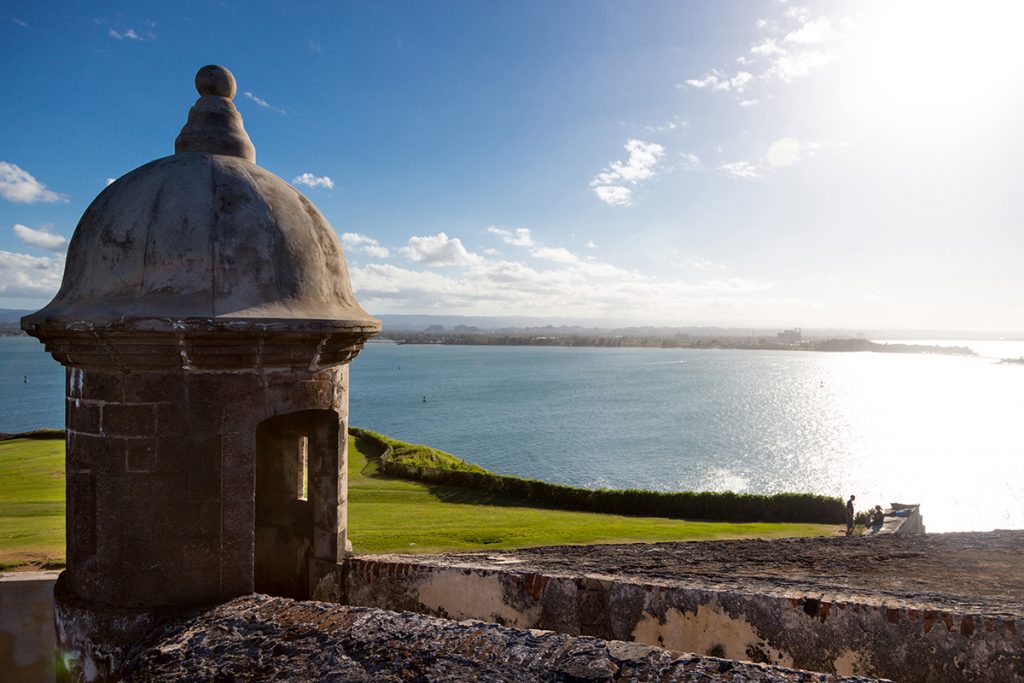
When we walked past later in the day, we saw lots of visitors on the lawns and walking on the path leading to the entrance.
Park Hours
The San Juan National Historic Site, which includes the El Morro Fort, is generally open every day from 9 a.m. until 6 p.m., except for Thanksgiving, Christmas, and New Year’s Day.
El Morro is part of the San Juan National Historic Site in Puerto Rico
Amenities at El Morro
Restrooms are located on the entrance level. There is a bookstore and gift shop with snacks, drinks, and souvenirs, also located on the main level. There is a water fountain, so bring your refillable water bottle and stay hydrated!
Viewing El Morro from San Juan Bay
El Morro looks stunning from the waters of San Juan Bay as well. Take a sunset sailing cruise in the bay to enjoy the views of the fort from the water!
Check availability and book your tour now!
Where to stay in Old San Juan
We stayed in the historic Hotel El Convento. The lovely old hotel is located in the heart of the historic district, convenient walking distance to most sights in the old city, including Castillo San Cristobal.
The lovely old hotel is located in the heart of the historic district, convenient walking distance to most sights in the old city, including Castillo San Cristobal.
Rooms are spacious, and furnishings elegant. We felt pampered, with turndown service and an evening reception with quality wine and cheese. You will love the rooftop pool with its beautiful views, and the courtyard restaurant is a happening place come evening.
Book a stay here
*****
So there you have it: the complete guide to visiting the El Morro fort in San Juan, Puerto Rico! Have you been? I would love to read your thoughts, if you have! Comment below to respond.
If you haven’t yet visited, consider planning a trip to San Juan: it’s a fascinating city (one of the top cities in the USA for weekend trips!) with lots of interesting sights and great food and drink.
And if you are planning a visit to Puerto Rico, check out my Puerto Rico itinerary for a fun-filled trip to the beautiful Caribbean island!
Also check out our other in-depth guides for other famous sights around the world:
- California: What to Do at the Cabrillo National Monument in San Diego
- Rome: Tips for Visiting the Borghese Gallery
- Bergen: Riding the Floibanen Funicular to the Top of Mt.
 Floyen
Floyen - Stockholm: A Guide to Stockholm’s Subway Art
- Italy: 20 Spectacular UNESCO World Heritage Sites in Italy
- Massachusetts: Visiting the Boston Public Garden
- Seville: Visit the Royal Alcazar of Seville!
Did you find this article informative? Pin it for later reference!
El Morro: The Great 16th Century Fort That Saved Puerto Rico from British and Dutch Invasions
Updated
10 October, 2017 – 23:04
ML Childs
Castillo de San Felipe del Morro is a fort that sits majestically on the northeastern coast of Puerto Rico in the capital city of San Juan. In 1983, the fort was declared a world heritage site by the United Nations for its historical significance and for its astounding military engineering of “stout walls, carefully planned steps, and ramps for moving men and artillery.” Millions of tourists converge on this site annually to learn about its historical importance in the region; but, some of these tourists also visit because they have heard about the alleged hauntings that occur at the fort.
History of San Juan and Its Fort
When explorers arrived in the Americas from Spain, they would settle an area, claiming it for the Spanish empire. Puerto Rico was one of the first islands discovered in the New World by Genoese captain, Christopher Columbus in 1493. It was later settled in 1508 by Juan Ponce de Leon who enslaved the native population of Taino Indians under the repartimiento system in order to extract the gold from the area and establish a gold mining colony. Disease and famine caused the native population to dwindle drastically and as a result, in 1513 enslaved Africans were brought to the colony to mine and extract the gold under a new less repressive system known as the encomienda system.
Reconstruction of Taino village, Puerto Rico. ( CC BY-SA 2.5 )
Within a few decades, Puerto Rico became one of the wealthiest seaports in the Americas making it a target for other European nations exploring the New World. Not only was it a rich seaport, its strategic location in the Caribbean made it a sought-after piece of land because whoever owned this position could gain a foothold in the entire western world. The Spanish were aware of this vulnerability and thus made Puerto Rico’s coast one of the most densely fortified in the region.
Not only was it a rich seaport, its strategic location in the Caribbean made it a sought-after piece of land because whoever owned this position could gain a foothold in the entire western world. The Spanish were aware of this vulnerability and thus made Puerto Rico’s coast one of the most densely fortified in the region.
Work began on Castillo de San Felipe del Morro in the late 1530s to protect the Spanish conquistadors’ lands from attacks by seafaring enemies and the threat of pirates. The fort was named in honor of Philip II of Spain, but it is Charles V of Spain who ordered engineers Juan de Tejada and Juan Bautista Antonelli to design the fort. Once it was complete, the fort would prove its worth when Britain challenged its stronghold in 1595 under the leadership of Sir Francis Drake. Spanish settlers staved off his attack by shooting a cannonball into Drake’s ship causing his retreat.
- The Legend of the Fearsome Chupacabra in Puerto Rico
- The last traces of the Taino: Puerto Rican ceremonial sites stand as testament of a rich culture
- 5 Mythical Creatures – And Where to Find Them
Charles V in Armour by Peter Paul Rubens circa 1600 ( Public Domain )
The British Crown’s desire to acquire Spanish lands did not end with Drake’s defeat.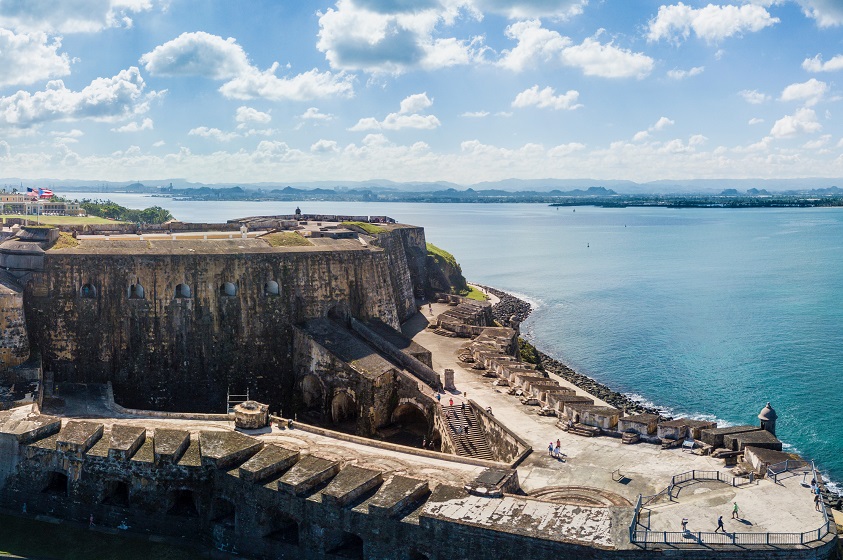 George Clifford, the 3 rd Earl of Cumberland, invaded Puerto Rico but instead of invading through the islet of Old San Juan as Drake had unsuccessfully done, he staged a land attack in which he was successful in overtaking the city.
George Clifford, the 3 rd Earl of Cumberland, invaded Puerto Rico but instead of invading through the islet of Old San Juan as Drake had unsuccessfully done, he staged a land attack in which he was successful in overtaking the city.
Earl of Cumberland’s Successful Takeover and His Ultimate Demise
It would seem that the Earl of Cumberland’s successful invasion in 1598 would spell victory for the British in the newly discovered territory. Unfortunately, the food that they had relied on to survive was contaminated by Puerto Rico’s ravaging summer heat. George, along with many of his soldiers fell victim to a foodborne illness which triggered dysentery, an intestinal infection that causes fever, abdominal pain, and bloody diarrhea. This forced George and his crew to leave the island and return to Britain; however, they didn’t leave empty-handed. Before heading back to Britain, they sacked the city and took anything of value that they could.
View of El Morro ( Castillo de San Felipe del Morro), San Juan ( Public Domain )
The Dutch Invasion of San Juan
As if the looming threat of the British wasn’t enough, the Spanish found themselves facing a new threat from the Dutch a few decades after the Earl of Cumberland’s invasion. Boudewijn Hendricksz decided to use George’s military action of overland invasion to achieve his aim of taking San Juan from the Spanish. Boudewijn may have assumed that this would be an easy defeat, but to his dismay, his strategy failed. His military forces sacked the city, but they weren’t able to capture it as he had planned.
Boudewijn Hendricksz decided to use George’s military action of overland invasion to achieve his aim of taking San Juan from the Spanish. Boudewijn may have assumed that this would be an easy defeat, but to his dismay, his strategy failed. His military forces sacked the city, but they weren’t able to capture it as he had planned.
The United States’ Takeover
Since the Spanish arrived in the 1500s, they were able to stave off an invasion from the British and the Dutch who coveted this land for its strategic location in the Caribbean and its gold. Although the British and the Dutch weren’t successful, the United States would become the only foreign invader to successfully take over the fort and the entire country during the Spanish-American War. The war ended with the Treaty of Paris turning Puerto Rico and several other islands over to the United States.
- Shipwreck found in Haiti may be Santa Maria, the flagship of Christopher Columbus
- Juan Ponce de León and his Search for the Fountain of Youth
- Local hikers discover Pre-European petroglyphs on the Caribbean Island of Montserrat
Photo from 5th level of El Morro looking out into the harbor. ( CC BY 3.0 )
( CC BY 3.0 )
Ghosts Invade El Morro
The US may have been the only successful invader to take over El Morro Fort in Puerto Rico. However, according to legend, several ghosts have made the fort their home, also. One such ghost that seems to be famous at the fort is the ghost known as the lady in white. This apparition is usually seen near a lighthouse known as La Garita del Diablo or the Devil’s Watchtower. Her apparition is usually seen floating along the ramparts.
View of a corner turret from one of the ramparts ( CC BY 2.0 )
Another legend is the legend of the ghost soldier that vanished . When Spanish soldiers manned the fort, they would call out the words “Alerta” or “Alert” which was their way of making sure that the soldiers were awake and watching over the fort. When one soldier didn’t hear a response, he went into the Garita (watchtower) to check on the soldier that was supposed to be stationed there. Upon arrival, the room was empty. The missing ghost soldier still haunts the fort.
Upon arrival, the room was empty. The missing ghost soldier still haunts the fort.
Aside from a ghost sighting or two, some say that they can hear footsteps of soldiers, yellow orbs floating around, or wailing sounds. Some have even reported feeling dizzy or queasy in certain areas near the fort. Whether visiting for historical reasons or to explore the paranormal, Castillo de San Felipe del Morro remains one of the marvels of the Americas linking the architecture of old medieval Spain to the modern world.
Ramparts of El Morro ( CC BY 2.0 )
Top image: Castillo de San Felipe del Morro (El Morro), Puerto Rica, (Image: puertorico.com)
By Melisha Childs
Related Articles on Ancient-Origins
10 October, 2022 – 22:53
ashley cowie
Polish archaeologists excavating a Roman military camp in Bulgaria expected to discover some coins; and they weren’t really surprised by the hoards of day-to-day tools and the expansive ancient water. ..
..
3 October, 2022 – 18:32
Sahir
A routine road construction project has led to the accidental discovery of an extensive network of underground corridors in Bam village of Esfarayen county in northeast Iran. Archaeologists have…
30 September, 2022 – 22:53
Nathan Falde
Over the last few decades, archaeologists from Bulgaria and Poland have been performing excavations at the site where the Roman legionary fortress of Novae once stood. The ruins of the fortress can…
27 December, 2021 – 18:00
Sahir
Between 43 AD and 410 AD, large parts of Britain were under Roman occupation. Part of the Roman empire’s eastwards occupation, these conquered territories had the status of a Roman province. The…
6 November, 2021 – 00:57
ashley cowie
Scottish archaeologists have released a mind-boggling 3D reconstruction of the largest royal Pictish fort ever discovered. Burghead Fort was the largest settlement of northern Picts in what is today. ..
..
29 October, 2021 – 22:52
Sahir
A Roman “carcer” is a holding cell for criminals and Roman gladiators awaiting their moment in the amphitheater, where bloodthirsty crowds eagerly anticipated the spectacle of their deaths. One such…
Fort El Morro In San Juan Puerto Rico Stock Photos
built structure
,
tourist spots
,
architecture and buildings
,
attractions
,
sea
,
sky,
old san juan,
San Juan – Puerto Rico,
puerto rico,
caribbean,
building exterior
ASSISTANT
blendshapes
DESCRIPTION
Fort El Morro in San Juan Puerto Rico
Similar images from iStock
| Save Now
Similar Free Photos of
not people
building exterior
large builds
Embedded Structures
textured
not people
city life
Built-in structures
hangar
construction industry
building exterior
Built-in structures
city
facade
urban scenes
Modern built-in structures
office building
window
personal perspectives
Modern built-in structures
tree trunk
wood
construction industry
Wooden log built structure
reflection
modern
Glass – Material
Glass, financial district structure built
modern
gray
conformity
Skyscraper, built structures, building outside
built structure
house
human hand
Gift of the house
built structure
illustrative
vector
Icon building
Similar images from iStock
| Save Now
El Morro Cannonballs Fort San Juan, Puerto Rico Stock Photos
Recent:
Thanksgiving Day
black Friday
Christmas
people
winter
the mountains
World map
reference Information
house
civil war
,
cannon
,
puerto rico
,
weapon
,
fort
,
San Juan – Puerto Rico,
morro,
architecture background,
cannonball dive,
architectural Detail,
architecture And Buildings,
monuments
Similar images from iStock
| Save Now
Similar Free Photos of
story
campfire
military
Civil War
Civil War
us civil war
civil war memorial
Civil War stamp
us civil war
illustrative
engraved images
American Civil War.
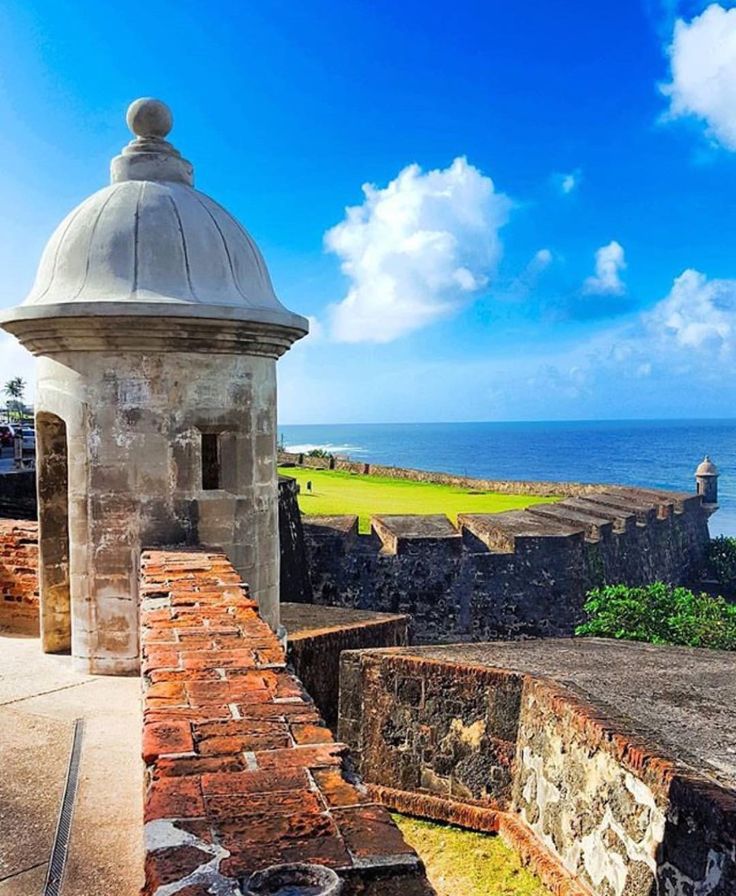
 Floyen
Floyen